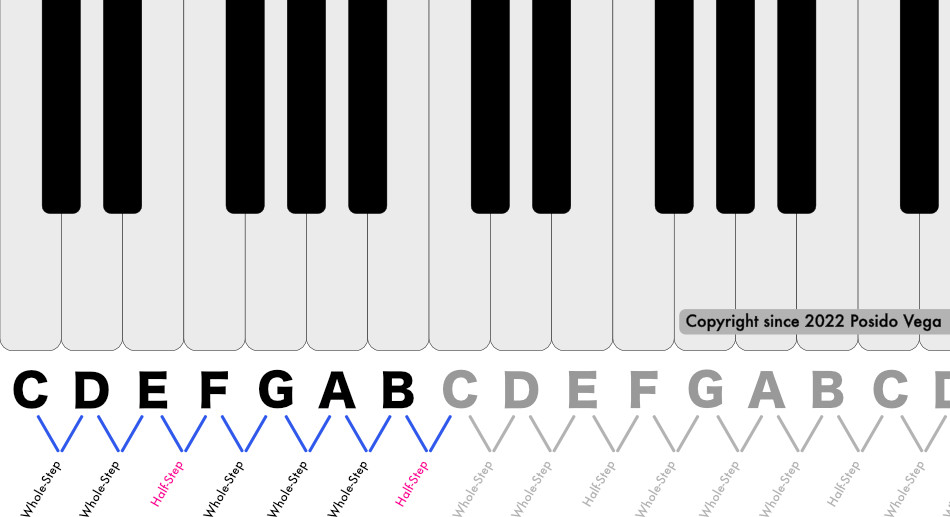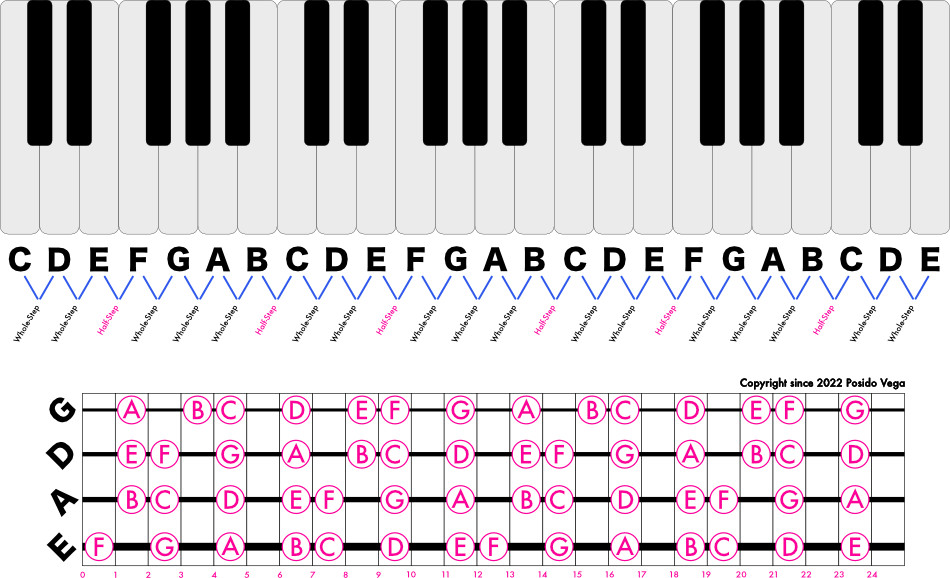For over a decade, I’ve guided countless bass students, and a recurring theme emerges: many, even seasoned players, grapple with complete fretboard note knowledge. This shouldn’t be the norm. Mastering your bass guitar notes is achievable and doesn’t require endless hours. The fretboard operates logically, and understanding this unlocks everything.
In this guide, you will learn: The definitive method I employed to internalize all bass frets and notes in just two weeks (accompanied by a video explanation).
Let’s dive in and decode the fretboard.
Your Step-by-Step System to Master Bass Guitar Notes
My proven approach to learning every note on the bass fretboard is distilled into these 4 straightforward steps:
I’ll elaborate on each step, providing helpful diagrams and a video walkthrough of the entire process.
Bookmark this page as your go-to resource, whether you’re a beginner just starting to explore bass notes or struggling to fully memorize the fretboard.
Quickstart Video Guide
If time is short, this video provides a concise breakdown of my method.
 YouTube video
YouTube video
Alt text: Video thumbnail: Learn Bass Guitar Fretboard Notes Fast! (4 Easy Steps) featuring a bass guitar neck and fretboard diagram.
Learn Your Fretboard Bass Guitar Notes Fast! (4 Easy Steps)
Step 1: Understanding the Interval Logic of Musical Notes
Western music, encompassing most genres, utilizes only 12 distinct notes. The most efficient way to learn these notes is to grasp the inherent logic of their arrangement – one note at a time.
Tip: Musical notes follow alphabetical order, from A to G. If you know your alphabet up to G, you’re already halfway there!
The notes A, B, C, D, E, F, and G are the foundation, known as natural notes. These correspond to the white keys on a piano.
This sequence repeats across all instruments: A, B, C, D, E, F, G, A, B, C, D, E, F, G, and so on.
The remaining 5 notes are sharps and flats: A♯/B♭, C♯/D♭, D♯/E♭, F♯/G♭, and G♯/A♭. These are analogous to the black keys on a piano, situated between the natural notes.
Sharps and flats offer two ways to name the same pitch, known as enharmonic spelling.
While the pitch remains constant, the spelling varies depending on the musical context. For beginners, focus on mastering the fretboard first; understanding spelling nuances will come with time.
Whole Steps and Half Steps Explained
Observing a piano, you’ll notice black keys between most white keys, except in two instances.
Tip: There’s no black key between E and F, and no black key between B and C. This principle applies directly to the bass fretboard and guitar fretboards!
 Piano keys – Whole-Step and Half-Step Diagram
Piano keys – Whole-Step and Half-Step Diagram
Alt text: Diagram of piano keys illustrating whole step and half step intervals between natural notes, highlighting E-F and B-C as half steps.
Piano keys – Whole-Step and Half-Step Diagram
The intervals between E and F, and B and C, are always a half step (one fret).
All other natural note intervals are whole steps (two frets).
Let’s immediately apply this understanding to the bass fretboard. This method is significantly less tedious than rote memorization of notes chromatically.
Step 2: Decoding the Bass Guitar Fretboard Logic
Previously, we established that:
- Musical notes are alphabetically ordered.
- E-F and B-C are always half steps apart.
- All other natural notes are whole steps (2 frets) apart.
The most critical fretboard logic to internalize is:
- Each fret on your bass represents a half step.
- Two frets constitute a whole step.
On a standard four-string bass guitar, the open string notes.) are E, A, D, and G.
 Bass Guitar Fretboard Notes and Piano Notes Diagram
Bass Guitar Fretboard Notes and Piano Notes Diagram
Alt text: Diagram comparing bass guitar fretboard notes on E, A, D, G strings to corresponding notes on a piano keyboard.
Bass Guitar Fretboard Notes and Piano Notes Diagram
Let’s focus on the lowest string, the E string, to begin learning bass guitar notes systematically, string by string.
Remember, E-F and B-C are the only natural note pairs without an intervening note.
Finding Notes on Your E-String (The Simple Approach)
Starting with the open E-string, the first fret is F.
Applying the alphabetical note logic reveals all natural notes on the E string:
- Two frets above F is G.
- Two frets above G is A.
- Two frets above A is B.
- One fret above B is C.
- Two frets above C is D.
- Two frets above D is E.
- This pattern then repeats up the neck.
Let’s apply this to the A-string.
Finding Notes on Your A-String (The Simple Approach)
Note locations on the A-string are:
- Two frets above A is B.
- One fret above B is C.
- Two frets above C is D.
- Two frets above D is E.
- One fret above E is F.
- Two frets above F is G.
- Two frets above G is A.
- This repeating pattern continues along the A-string.
Let’s continue to the D-string.
Finding Notes on Your D-String (The Simple Approach)
Note locations on the D-string are:
- Two frets above D is E.
- One fret above E is F.
- Two frets above F is G.
- Two frets above G is A.
- Two frets above A is B.
- One fret above B is C.
- Two frets above C is D.
- This pattern repeats up the D-string as well.
One string left! Let’s map the G-string notes.
Finding Notes on Your G-String (The Simple Approach)
Note locations on the G-string are:
- Two frets above G is A.
- Two frets above A is B.
- One fret above B is C.
- Two frets above C is D.
- Two frets above D is E.
- One fret above E is F.
- Two frets above F is G.
- The pattern repeats itself up the G-string.
Now, let’s accelerate your learning by exploring octaves.
Step 3: Utilizing Octave Shapes as Fretboard Landmarks
This step is vital for rapidly expanding your fretboard knowledge. Octaves serve as crucial signposts across the neck. While any interval, like a 5th, can act as a landmark, octaves are ideal for beginners because they represent the same note, simplifying recognition.
A perfect octave is the same note, doubled in frequency, either higher or lower.
Bass Guitar Fretboard Octaves Diagram
Here are easily memorized octave shapes:
- Two frets higher, two strings up: octave higher.
- Two frets lower, two strings down: octave lower.
- Three frets lower, three strings up: octave higher.
- Three frets higher, three strings down: octave lower.
- Five frets lower, one string up: octave higher.
- Five frets higher, one string down: octave lower.
- Seven frets higher, one string up: octave higher.
- Seven frets lower, one string down: octave lower.
Step 4: Practical Application in Musical Contexts
Steps 1-3 provide the knowledge base, but Step 4, applying logic and octave landmarks, is key to rapid fretboard mastery.
Tip: Practice is essential. You must play your bass and actively apply your knowledge.
Consistent practice solidifies note recognition and accelerates fretboard mastery.
In the video, I demonstrate applying these concepts using a simple bass line and a metronome. By thinking about octave locations while playing root notes and then playing the same line an octave higher, you’ll quickly internalize note positions.
(Bonus) Step 5: Verbalize Note Names During Practice
During each practice session, dedicate a few minutes to consciously saying note names aloud.
Practice slowly, prioritizing accuracy over speed.
This technique significantly accelerates note learning. I personally used this method, saying the note name, locating it on the fretboard, then playing it. When learning to read standard music notation, verbalizing note names reinforced fretboard locations.
I integrated this into band practice, jams, and even live performances. This way, learning becomes integrated with real-time playing.
This forced on-the-fly thinking and boosted confidence, especially when starting out.
Your Turn to Play
Knowledge of logic and octaves is valuable, but applying it is transformative.
Mastering bass guitar notes is crucial for improvisation, music reading, and playing from chord charts rhythmically.
Start applying these techniques, and you’ll see significant progress within weeks.
For more bass education, explore My Sandbox.
Frequently Asked Questions
What are the Notes on a Bass Guitar? (Standard Tuning)
On a 4-string bass, the string notes in standard tuning are: E, A, D, and G.
A 5-string bass is tuned to: B, E, A, D, and G.
A 6-string bass is tuned to: B, E, A, D, G, and C.
Standard bass tuning is in fourths. Understanding fourth intervals, like octaves, is another helpful pattern for learning notes across strings.
What’s the Most Effective Way to Memorize Bass Guitar Notes?
A common question is, “How do I memorize bass notes?”
My answer is always, “You don’t just memorize.”
Understanding note spelling logic and fretboard layout is paramount. Once you grasp these, fretboard locations become intuitive.
Develop good habits: observe patterns, shapes, and verbalize note names. Trust the process.
Natural memorization arises from finding relationships and meaning within the information. Pattern and shape recognition are key to establishing these mental connections.
How to Locate Notes on the Bass Guitar?
To find notes on bass, understand the fretboard. A standard 4-string bass (E, A, D, G) fretboard mirrors a piano in layout. Natural notes are whole steps apart, except for E-F and B-C (half steps). All other natural note pairs are whole steps apart.

